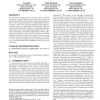Free Online Productivity Tools
i2Speak
i2Symbol
i2OCR
iTex2Img
iWeb2Print
iWeb2Shot
i2Type
iPdf2Split
iPdf2Merge
i2Bopomofo
i2Arabic
i2Style
i2Image
i2PDF
iLatex2Rtf
Sci2ools
BCSHCI
2009
2009
Low-fi skin vision: a case study in rapid prototyping a sensory substitution system
We describe the design process we have used to develop a minimal, twenty vibration motor Tactile Vision Sensory Substitution (TVSS) system which enables blind-folded subjects to successfully track and bat a rolling ball and thereby experience `skin vision'. We have employed a lo-fi rapid prototyping approach to build this system and argue that this methodology is particularly effective for building embedded interactive systems. We support this argument in two ways. First, by drawing on theoretical insights from robotics, a discipline that also has to deal with the challenge of building complex embedded systems that interact with their environments; second, by using the development of our TVSS as a case study: describing the series of prototypes that led to our successful design and highlighting what we learnt at each stage. Categories and Subject Descriptors H.4 [Information Systems Applications]: Miscellaneous Keywords Lo-Fi Rapid Prototyping, Tactile Vision Sensory Substitution...
BCSHCI 2007 | BCSHCI 2009 | Lo-fi Rapid Prototyping | Tactile Vision Sensory | Vision Sensory Substitution |
| Added | 08 Nov 2010 |
| Updated | 08 Nov 2010 |
| Type | Conference |
| Year | 2009 |
| Where | BCSHCI |
| Authors | Jon Bird, Paul Marshall, Yvonne Rogers |
Comments (0)

